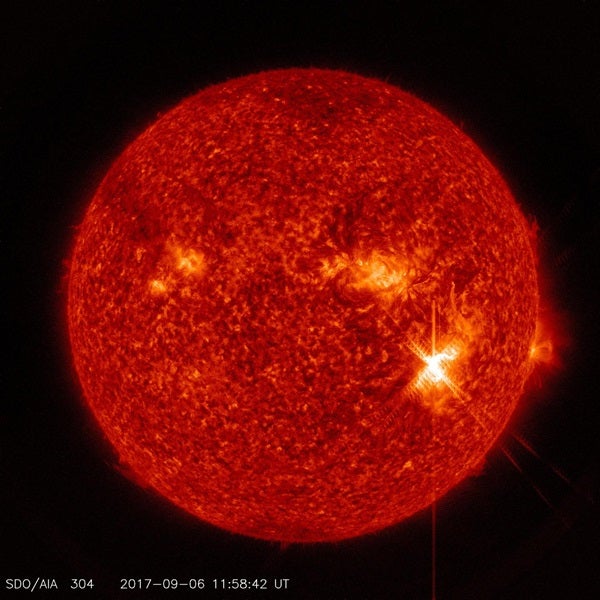The two flares occurred Wednesday morning at 5:10am and 8:02am EDT. Of the two, the latter was the strongest solar flare we’ve observed from the Sun since one that occurred December 5, 2006. They were spotted by NASA’s Solar Dynamics Observatory (SDO), which is tasked with continuously monitoring our star to help scientists better understand its variability and the impact of solar activity on Earth and the space around our planet.
Solar flares typically erupt from or near sunspots, which are cooler areas on the surface of the Sun associated with localized buildups in the star’s powerful magnetic field. Physicists believe the magnetic field can become twisted and looped as the Sun rotates, until finally these lines “snap.” As this occurs and magnetic energy is released, it triggers a massive eruption of energy across many wavelengths, including X-rays. Flares can last for minutes or hours, raising the local temperature of the Sun’s surface by tens of millions of degrees. Oftentimes, solar flares are also associated with coronal mass ejections (CMEs), which throw out super-heated plasma from the Sun into space.
Wednesday’s flares were ranked using the X-class system, which is used to measure the intensity of particularly strong flares. In this system, an X2 flare is twice as strong as an X1 flare, an X3 flare is three times as strong as an X1 flare, and so forth. The 5:10am event was an X2.2 flare, while the 8:02am event topped out as an X9.3 flare; the previous record-holder 2006 flare was an X9.0.
Both flares released Wednesday can be seen in this animation, which features the Sun viewed at 131 Angstroms. This wavelength shows material in flares at temperatures over 10,000,000 Kelvin (18,000,000 Fahrenheit [10,000,000 Celsius]).
NASA/Goddard/SDO
There are several ranking categories used to measure solar flares, with the strongest receiving a C, M, or X rating. Each category represents a tenfold increase in energy, so that M flares are 10 times stronger than C flares, and X flares are 10 times stronger than M flares (and 100 times stronger than C flares). A- and B-class flares are weaker still.
While C-class flares are strong, they don’t represent any concern for Earth or near-Earth space. M-class flares may cause brief radio blackouts in polar regions and minor concern for any orbiting astronauts. X-class flares, such as the ones seen Wednesday morning, can cause more significant and widespread effects, including longer blackouts and radiation storms that affect some or all of the planet.
The flares that occurred September 6 were responsible for high-frequency radio blackouts on the dayside of the planet lasting an hour. While no particles associated with a CME have yet hit Earth, solar scientists are monitoring the data from available Sun-orbiting satellites to determine whether this could occur. When the particles of a CME blow past our atmosphere, they can cause further problems that can include satellite and power grid disruptions.
The Sun may not be done yet, either — the large group of sunspots, which is visible through a protective solar filter (including those solar eclipse glasses you may still have lying around), has already sent out other, weaker M-class flares. They could still be responsible for additional flares in the coming days. SDO and other satellites will continue monitoring the Sun for such events.










